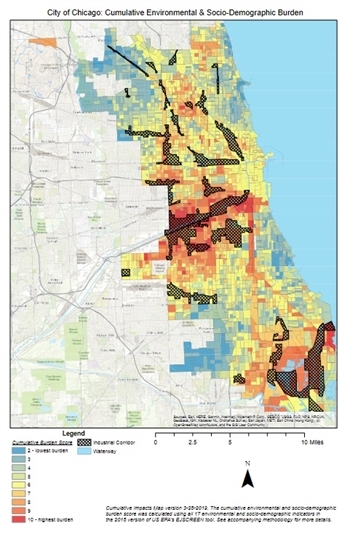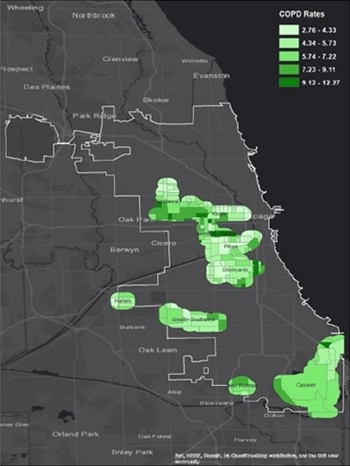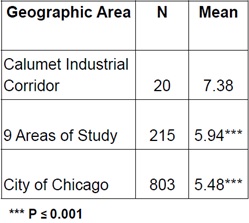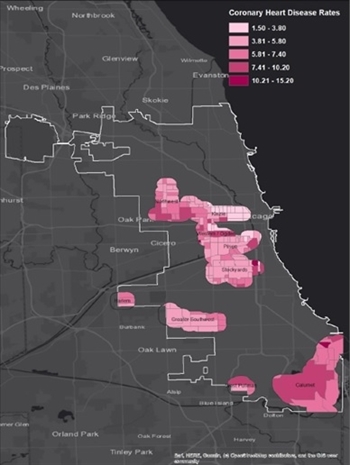Lens on the Calumet Corridor | Living or Working In a Polluted Community Harms Your Health


An environmental justice collaborative in Southeast Chicago spent two years studying the lasting health impacts of industry in their community. Lens on the Calumet Corridor: A blog series highlighting the research in the Calumet Connect Data Book captures what they discovered, and why it’s time for a change. This is the fourth blog in our six-part series.
Calumet Corridor residents love many things about their community. But there’s an invisible cost to living in this river-adjacent geography in Southeast Chicago.
Recent data reveals that the rates at which Calumet Corridor residents suffer from illness, including chronic obstructive pulmonary disease and heart disease, are higher than for Chicago residents overall in a statistically significant way.
Illness is a high price to pay to live in any neighborhood. And in recent years, public health professionals have recognized the importance of housing as a social determinant of health. In addition to housing structure and condition, “social, physical and economic characteristics of neighborhoods have been increasingly shown to affect short- and long-term health quality and longevity,” and, therefore, have been included in the dialogue of what a home means in regards to health outcomes.
People living in the Calumet Corridor experience disproportionate rates of chronic disease
In 2018, the Natural Resources Defense Council (NRDC) conducted a mapping analysis to identify communities within the City of Chicago susceptible to disproportionate cumulative impacts that account for environmental and sociodemographic factors which act as indicators of vulnerability. The industrial corridor located near the Calumet River and Lake Calumet was one of the industrial corridors identified as facing disparate, cumulative burdens evident from the map produced by NRDC shown in Figure 1.

Acknowledging the land-use history of the Calumet Industrial Corridor, part of our study identified public health implications tied to corridor planning decisions. To conduct this analysis, the study team examined health data available at the census tract level for adult residents for the prevalence of chronic obstructive pulmonary disease (COPD) and Coronary Heart Disease. The data available for the Calumet Industrial Corridor was compared to both the City of Chicago as a whole and eight additional comparison industrial corridors that have a similar amount of land area zoned as a Planned Manufacturing District. The study team conducted t-tests, which tests for statistically significant differences between the means (average values) of two groups. In this case, the two groups are represented by the mean of the adult rate of a disease within the Calumet Corridor versus the mean of the adult rate of the same disease within the city as a whole or versus the comparison corridors. Our analysis revealed disproportionate rates of chronic disease within the Calumet Industrial Corridor.
Chronic obstructive pulmonary disease is prevalent
The average adult rate of COPD within the Calumet Corridor is statistically higher than the average adult rate in the City of Chicago. In reviewing data on COPD, summary statistics (Table 1) indicate that the average rate of COPD for the corridor (6.68) is larger than that of the other comparison areas (6.04) and the City of Chicago (6.04). However, at the 5% level of significance rates of COPD are only larger for the City of Chicago and not the comparison areas. At a 95% confidence threshold, a p-value less than or equal to 0.05 indicates a statistically significant difference exists between the rates of each chronic condition/health index value as observed inside and outside of the study area.


Coronary heart disease rates are high
The average adult rate of coronary heart disease within the Calumet Corridor is statistically higher than the average adult rate in the City of Chicago and in comparison corridors. Our summary statistics (Table 2) indicate that the average rate of coronary heart disease for the corridor (7.38) is larger than that of the other comparison areas (5.94) and the City of Chicago (5.48). At the 5% level of significance, the coronary heart disease rates for the corridor are larger than that of the nine areas of study, and the City of Chicago, on average.


Working and living in the Calumet Corridor can negativel impact health
With Americans spending approximately one-third of their lifetimes at work, it is unsurprising that one’s workplace can have a significant impact on quality of life. In addition to finding that study area residents were disproportionately impacted by specific chronic ailments, our study revealed that most of the employees of the Calumet Industrial Corridor facilities also live within the study area boundary itself. This means that they comprise a large share of those in the residential population that are dually exposed to toxic releases and environmental health hazards in both work and homelife.
City must acknowledge systemic burdens and repair harm
What the data has continued to reveal, is that residents of the Calumet Industrial Corridor have been made to bear the heavy burdens of equity-deficient decision-making for far too long. Particularly given the study area’s population demographics being primarily Latinx and African-American, it is important to grasp the implications of this legacy of planning
The common narrative expressed by Southeast Side Chicago residents that participated in focus groups (as part of the qualitative community needs assessment of our study) was that “the common story of the Southeast side is one that references beauty, a strong community, a history of industry, and an experience of physical isolation from the rest of the city and exploitation by industry (Phase I, pgs. 234-235). “ This narrative is not only a sentiment of their home, but it is also a reflection of our findings.
As efforts are being made to improve the industrial planning process, the City must acknowledge the legacy that inequitable planning has played within the Calumet Industrial Corridor. The first priority in the City’s efforts to plan for new or different land uses in its industrial corridors, like the Calumet, must be to protect public health and the environment, while fostering new patterns of economic and job growth within these communities. This must include active, systemic efforts to engage and share power with the residents who claim these corridors as their homes to repair this harm. Official engagement processes should not merely focus on making space for community voice; instead, these processes must go further, with an emphasis on operationalizing community desires.
Want to get Involved?
https://www.claretianassociates.org/
References
https://www.rwjf.org/en/library/research/2011/05/housing-and-health.html
